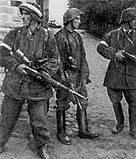Operation Most III
| Part of a series on the |
Underground State |
|---|
 |
This article needs additional citations for verification. (September 2014) |


Operation Most III (
Background
From November 1943 onwards, the Intelligence Division of the
Operation
On the night of July 25, 1944, just past 10:00 p.m., a
Hastily, the mud was shovelled away and another attempt was made to take off, but the wheels of the plane had sunk even deeper in the mud. Attempts to lodge sticks under the wheels were unsuccessful. Some partisans began digging around the wheels with their bare hands while others found wooden slats in the nearby woods that were subsequently wedged underneath the wheels. Finally the plane pulled out of the mud and was able to take off with the V-2 components before detection by German military units.[1]
Two days later the Dakota arrived in London. British scientists began devising a way to interfere with the guidance of the V-2 missile using radio waves, but it was discovered that the V-2 mechanism was not designed to "react to countermeasures by radio."[2]
Participants
On the outgoing flight from Brindisi the aircraft had 4 passengers: Kazimierz Bilski, Jan Nowak-Jeziorański, Leszek Starzyński and Bogusław Wolniak.
On the return flight, Jerzy Chmielewski, Józef Retinger, Tomasz Arciszewski, Tadeusz Chciuk, and Czesław Miciński were ferried from occupied Poland to Brindisi, Italy. It was intended that
The aircraft's crew included: F/Lt S.G. (George) Culliford (Captain), F/O Kazimierz Szrajer (Co-pilot and translator) (Polish), F/O J.P. Williams (Navigator), F/Sgt J. Appleby (Radio-operator).[3]
Security for the operation was provided by Armia Krajowa group “Urban”, which included Adam Gondek 'Kruk'. The security commander of the Motyl landing site was
Other participants were : Kpr. Franciszek Nowak 'Pomidor', Dr Jan Deszcz 'Wacek', Kpr. pchor. Władysław Bysiek 'Morena', Józef Lupa 'Czarny Sęp', Ppor. Franciszek Kuczek 'Deska', Por. Mieczysław Czech 'Jurand', Por. Paweł Chwała 'Skory', Ppor. Jan Gomoła 'Jawor'.
Media appearance
Dramatisation of the events was published in the book
The operation was featured in the 1977 BBC TV series The Secret War, episode 3, "Terror Weapons", which included Janusz Groszkowski's memories of the operation.
Operation Most III was one of the major plot elements in Frozen Flashes ("Gefrorene Blitze"), a GDR movie about the development of the V2 and the history of the resistance movement in Peenemünde during the Second World War and its attempt to sabotage the V-2 programme.
See also
- Battle of the V-1
- Home Army and V1 and V2
- Polish contribution to World War II
References
- ISBN 0-275-94481-6.
- ISBN 0-275-94481-6.
- ^ Szrajer, Kazimierz. ""Trzeci Most" - Wspomnienia Kaziemierza Szrajera". Archived from the original on 27 March 2010.
Bibliography
- Breuer, William B. (1993). Race to the Moon: America's Duel with the Soviets. Westport; Connecticut: Praeger Publishers. ISBN 0-275-94481-6
- Ordway, Frederick I., III. The Rocket Team. Apogee Books Space Series 36 (pp. 158, 173)
- (in Polish) Michał Wojewódzki, Akcja V-1, V-2, Warsaw 1984, ISBN 83-211-0521-1
- McGovern, James. Crossbow and Overcast. W. Morrow: New York, 1964. (p. 71)
